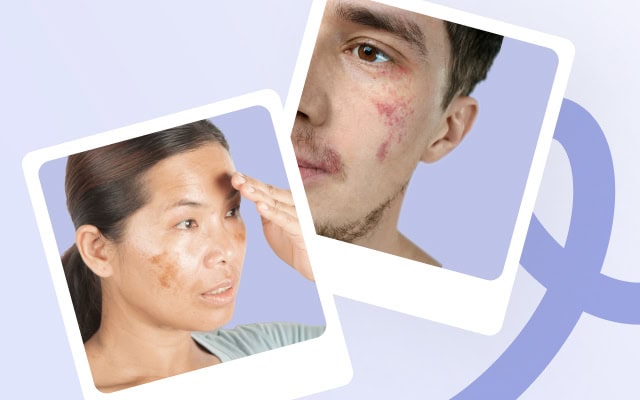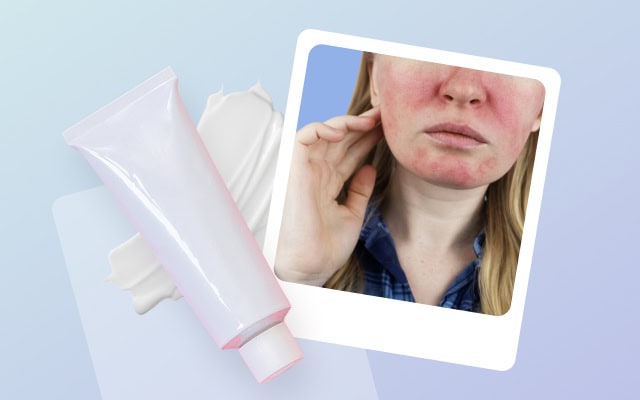Spongiotic dermatitis: What is it and what is the best treatment?
Dr. Aditi Shende, board-certified dermatologist talks about the symptoms, causes and treatment for spongiotic dermatitis and gives you some tips on how to manage it.
Table of Content:
What is spongiotic dermatitis? | Symptoms | Causes and triggers | How to get treatment? | Best medications | | Tips to manage it | FAQ
Our commitment to producing high-quality content:
The information presented in this article is based on scientific research and the professional advice of our Content Medical Reviewers, who are experts in the field of Dermatology. How we write our content →
What is spongiotic dermatitis?
Spongiotic dermatitis (also known as acute eczema or acute dermatitis) is a form of skin inflammation marked by fluid buildup between the cells of the epidermis. This accumulation causes a sponge-like appearance under microscopic examination, which gives the condition its name. The fluid buildup leads to redness, swelling, itching, and general skin discomfort.
Often linked to eczema (atopic dermatitis), spongiotic dermatitis commonly presents as red, itchy patches that may ooze, crack, or become scaly. It typically arises in response to allergens or irritants, though genetic predisposition and immune system dysfunction can also contribute to its development. The condition can affect individuals of any age and may range in severity from mild irritation to intense flare-ups.
According to board-certified dermatologist Dr. Aditi Shende, board-certified dermatologist, spongiotic dermatitis can be tricky to diagnose because it may stem from a variety of causes and present a broad range of symptoms—not all of which may appear at once. This variability makes a thorough clinical evaluation essential.
Dr. Shende says that spongiotic dermatitis frequently appears on areas like the chest, abdomen, buttocks, and limbs, and is characterized by recurrent flare-ups. During these episodes, the skin becomes highly sensitive and inflamed. While the condition is often chronic, symptoms can be managed effectively with the right treatment and preventive care. Dr. Shende emphasizes that treatment depends on identifying and addressing the underlying trigger—whether it’s an allergen, irritant, or an associated skin condition.
This article covers the basics on spongiotic dermatitis so you and your online dermatologist can make an informed decision on the best treatment for you.
Spongiotic dermatitis symptoms
Dr. Shende says that the most common spongiotic dermatitis symptoms are:
- Fluid buildup: One of the hallmark signs is the accumulation of fluid between skin cells in the outer layer (epidermis), which contributes to swelling, blistering, and discomfort.
- Itching: Spongiotic dermatitis can feel intensely itchy, and scratching may worsen the irritation or lead to skin damage.
- Redness: The affected skin typically becomes red or pink due to inflammation.
- Inflammation: Swelling is common, as the skin reacts to irritation or allergens.
- Burning or stinging: Some individuals report a burning or stinging sensation in the inflamed areas.
- Distribution in many areas of the body: It can appear on various body parts, often in flexural areas like the inner elbows, behind the knees, or on the hands and feet.
- Blistering: Tiny fluid-filled blisters may develop, giving the skin a bubbly or raised appearance.
- Oozing: If the blisters rupture, the skin may leak a clear or yellowish fluid.
- Scaling: As the condition progresses, the skin may become dry, flaky, or crusted.
- Recurrence: Flare-ups may occur periodically, especially if the underlying cause isn’t properly addressed.
Secure, confidential, and reviewed by board-certified dermatologists.
Spongiotic dermatitis triggers and causes
According to Dr. Shende, spongiotic dermatitis, can be triggered or caused by a wide range of factors such as:
Contact irritants
Exposure to everyday irritants—such as harsh soaps, laundry detergents, cleaning agents, or personal care products with fragrances—can disrupt the skin barrier and trigger spongiotic dermatitis. Repeated contact often worsens inflammation and leads to flare-ups, especially on the hands and face.
Allergens
Allergic reactions to substances like pollen, pet dander, mold, dust mites, or certain foods can provoke an immune response that inflames the skin. Many skincare products also contain preservatives or fragrances that may act as allergens for sensitive individuals.
Underlying skin conditions
Spongiotic dermatitis commonly appears in people with pre-existing skin conditions like eczema, contact dermatitis, or psoriasis. These chronic issues compromise the skin barrier, making it more reactive to external triggers and prone to inflammation.
Genetic predisposition
Individuals with a family history of eczema, asthma, or seasonal allergies are more likely to develop spongiotic dermatitis. Genetic factors can impair the skin’s natural defenses, making it more susceptible to irritation and immune overreaction.
Immune system overreaction
In some cases, the immune system may overreact even in the absence of a clear trigger. This hypersensitivity can result in inflammation, fluid buildup, and the characteristic symptoms of spongiotic dermatitis.
Stress
Emotional and physical stress is known to impact skin health. For many individuals, stress can act as a trigger or exacerbating factor, leading to flare-ups even when other irritants are not present.
Environmental factors
Extreme weather conditions—such as hot, humid climates or cold, dry air—can aggravate spongiotic dermatitis. Excessive sweating or rapid changes in temperature may also lead to irritation, especially in sensitive areas of the body.
Medications
Certain medications, particularly those that cause allergic reactions or increase skin sensitivity, can trigger spongiotic dermatitis. Both topical and oral drugs have been linked to flare-ups, often requiring a switch in treatment under medical guidance.
Spongiotic dermatitis foods to avoid
According to Dr. Shende, some people may experience spongiotic dermatitis as a result of food allergies or sensitivities. This does not mean that you cannot eat all these foods, what means is that if you have an allergy or sensitivity to one or more of these foods, you can have a skin reaction.
A food allergy testing can help identify if you have a food sensitivity that may trigger your spongiotic dermatitis.
Common food allergens include:
- Dairy products
- Eggs
- Nuts
- Soy
- Gluten
- Shellfish
- spicy foods
- Alcohol
- Food additives and preservatives
- Histamine-rich foods (aged cheeses, certain wines, and fermented foods)
How to get spongiotic dermatitis treatment?
Since spongiotic dermatitis is a chronic condition, it requires ongoing care to manage flares and keep symptoms under control. With Miiskin, you can consult an independent, board-certified dermatologist from the comfort of your home—quickly, affordably, and securely. The consultation price is just $59. Simply answer a few questions, upload photos of your skin, and receive a personalized treatment plan within 1–2 days.
Secure, confidential, and reviewed by board-certified dermatologists.
Best medications for spongiotic dermatitis
Topical corticosteroids
- Examples: Hydrocortisone, Triamcinolone, Clobetasol
- Use case: First-line treatment for reducing inflammation and itching
- Route: Topical
- Average price: $10–$60 (generic), up to $200+ (brand)
Topical calcineurin inhibitors
- Examples: Tacrolimus (Protopic), Pimecrolimus (Elidel)
- Use case: Alternative to steroids, suitable for sensitive areas (e.g., face, eyelids)
- Route: Topical
- Average price: $200–$400 per tube (brand; limited generic availability)
Antihistamines
- Examples: Cetirizine, Loratadine, Diphenhydramine
- Use Case: Relieves itching, especially helpful at night
- Route: Oral
- Average Price: $5–$20 per month (OTC or generic)
Phosphodiesterase-4 (PDE4) Inhibitors
- Examples: Eucrisa and Zoryve
- Use Case: Reduces inflammation in mild to moderate dermatitis; steroid-free option
- Route: Topical
- Average Price: $650–$750 per 60g tube (brand only)
Janus Kinase (JAK) Inhibitors
- Examples: Opzelura (Topical) and Rinvoq and Cibinqo (oral)
- Use case: Severe or treatment-resistant spongiotic dermatitis
- Route: Topical or Oral
- Average Price:
- Topical: $2,000+ per tube
- Oral: $5,000–$6,000 per month (brand only)
Secure, confidential, and reviewed by board-certified dermatologists.
Dermatologist tips to manage spongiotic dermatitis
Managing spongiotic dermatitis involves a combination of self-care practices and medical treatment under the guidance of a dermatologist or healthcare provider.
- Consult a dermatologist if you suspect you have spongiotic dermatitis or experience persistent skin symptoms to get a proper diagnosis and treatment plan.
- Determine what triggers or exacerbates your spongiotic dermatitis and take steps to avoid them. This may include identifying and eliminating allergens or irritants from your environment.
- Follow a gentle skincare routine. Use mild, fragrance-free soap and avoid hot water, which can strip the skin of natural oils. Pat your skin dry gently after bathing instead of rubbing.
- Apply moisturizers and emollients regularly to keep your skin hydrated. Moisturizers help to prevent dryness and reduce itching. Opt for products designed for sensitive skin.
- If prescribed by your dermatologist, use topical corticosteroids, calcineurin inhibitors, or other prescribed medications as directed. Follow the recommended application instructions and duration of use.
- If itching is a significant symptom, using an over-the-counter or prescription antihistamines may help relieve it
- Avoid scratching or rubbing the affected areas, as this can worsen inflammation and lead to skin damage and infection.
- Avoid tight clothing as it may irritate the skin. Wear loose fitting soft cotton clothes.
- Patients with atopic dermatitis should consider adding probiotics (like yogurt) to their diet. 9
- Apply cool, damp compresses to the affected areas to soothe itching and inflammation.
- Practice stress-reduction techniques such as mindfulness, meditation, yoga, or deep breathing exercises.
- Keep scheduled follow-up appointments with your dermatologist to assess the progress of your treatment and make any necessary adjustments.
- In extreme weather conditions, protect your skin from harsh elements. Use sunscreen, wear protective clothing, and moisturize to prevent dryness and irritation.
FAQ about spongiotic dermatitis
Is spongiotic dermatitis contagious?
Dr. Shende says that like all other types of dermatitis, spongiotic dermatitis is not contagious.
Is there a cure for spongiotic dermatitis?
Dr. Shende says there is no cure for spongiotic dermatitis, but with consistent care, it can be managed. During flare-ups, you can use topical corticosteroids along with fragrance-free moisturizers to strengthen the skin barrier. You should also learn to Identify and avoid irritants or allergens—such as harsh soaps, fragrances, or certain metals—is key to preventing recurrence. In some cases antihistamines can help with itching, and if needed, your dermatologist may prescribe a topical cream.
Is spongiotic dermatitis chronic?
Dr. Shende says that spongiotic dermatitis is often a chronic condition, especially when it’s linked to underlying issues like atopic dermatitis (eczema) or allergic contact dermatitis. It tends to come and go in flares, triggered by irritants, allergens, or stress. While it may clear completely at times, it can return if the skin is exposed to triggers again. Long-term management focuses on preventing flare-ups and maintaining healthy skin.
Is spongiotic dermatitis an autoimmune disease?
Dr. Shende says that while spongiotic dermatitis is not an autoimmune disease, it can be caused by various underlying conditions or triggers, some of which may have autoimmune components.
What is subacute spongiotic dermatitis?
Dr. Shende says the term “subacute spongiotic dermatitis” refers to the stage of the condition. Subacute dermatitis is a stage between acute (early or initial) and chronic (long-lasting) phases of skin inflammation. In this stage, the skin changes may be somewhat more established than in the acute phase but have not progressed to the level of chronic or long-term inflammation.
What is psoriasiform spongiotic dermatitis?
Dr. Shende says that psoriasiform spongiotic dermatitis is a skin condition identified by a combination of microscopic features seen in both psoriasis and spongiotic dermatitis. It’s not a standalone diagnosis but rather a pattern on a biopsy that suggests overlapping traits—thickened skin layers like psoriasis and fluid between skin cells like eczema. This pattern can appear in various conditions such as nummular eczema, seborrheic dermatitis, or certain reactions to medications. Clinically, it may show up as red, scaly, and itchy patches or plaques. Treatment usually involves topical corticosteroids, moisturizers, and avoiding known triggers, depending on the underlying cause.
Provider & Prescription Information
Miiskin connects patients with independent dermatologists who provide care through their private practices. Compounded prescriptions can be ordered via Miiskin and are dispensed by Foothills pharmacy. Standard medications can be issued for any local pharmacy.
Article References:
https://www.ncbi.nlm.nih.gov/pmc/articles/PMC8495556/
https://www.hmpgloballearningnetwork.com/site/thederm/dermatopathologist/spongiotic-dermatitis-differential-diagnosis-and-elusive-etiology
https://www.mayoclinic.org/diseases-conditions/dermatitis-eczema/symptoms-causes/syc-20352380
https://www.ncbi.nlm.nih.gov/pmc/articles/PMC6582261/
https://eczema.org/information-and-advice/treatments-for-eczema/topical-calcineurin-inhibitors/
https://www.ncbi.nlm.nih.gov/pmc/articles/PMC8163952/
https://jamanetwork.com/journals/jamadermatology/fullarticle/2729076
https://www.ncbi.nlm.nih.gov/pmc/articles/PMC6035868/
https://www.ncbi.nlm.nih.gov/pmc/articles/PMC9386980/
https://www.ncbi.nlm.nih.gov/pmc/articles/PMC9392967/
Skin conditions and treatments
Articles reviewed by dermatologists
Facial treatment for seborrheic dermatitis
How to get rid of rosacea permanently?
How to calm a rosacea flare-up fast?
Spongiotic dermatitis: What is it and what is the best treatment?





 Still dealing with skin issues? Get expert help from home.
Still dealing with skin issues? Get expert help from home.
